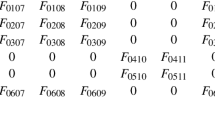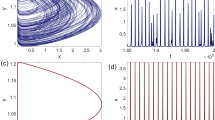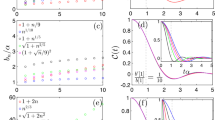Abstract
We present a new aggregation model on the space of rank-m tensors with the same size, and study emergent dynamics of the proposed model. Our proposed new aggregation model is general enough to encompass Lohe type models such as the Kuramoto model, the Lohe sphere model and the Lohe matrix models for the ensemble of real rank-0, rank-1 and rank-2 tensors, respectively. In this regard, we call our proposed model as the Lohe tensor model for rank-m tensors with the same size. For emergent dynamics of the proposed model, we employ the ensemble diameter as a Lyapunov functional to derive a Riccati type differential inequality. As a direct application of these differential inequalities, we provide two sufficient frameworks leading to the emergent dynamics for homogeneous and heterogeneous ensembles in terms of system parameters and initial data.
Similar content being viewed by others
References
Acebron, J.A., Bonilla, L.L., Pérez Vicente, C.J.P., Ritort, F., Spigler, R.: The Kuramoto model: a simple paradigm for synchronization phenomena. Rev. Mod. Phys. 77, 137–185 (2005)
Aeyels, D., Rogge, J.: Stability of phase locking and existence of frequency in networks of globally coupled oscillators. Prog. Theor. Phys. 112, 921–941 (2004)
Albi, G., Bellomo, N., Fermo, L., Ha, S.-Y., Kim, J., Pareschi, L., Poyato, D. and Soler, J.: Vehicular traffic, crowds and swarms: From kinetic theory and multiscale methods to applications and research perspectives. To appear in Math. Models Methods Appl. Sci
Bellomo, N., Ha, S.-Y.: A quest toward a mathematical theory of the dynamics of swarms. Math. Models Methods Appl. Sci. 27, 745–770 (2017)
Benedetto, D., Caglioti, E., Montemagno, U.: On the complete phase synchronization for the Kuramoto model in the mean-field limit. Commun. Math. Sci. 13, 1775–1786 (2015)
Bridgeman, J.C., Chubb, C.T.: Hand-waving and interpretive dance: an introductory course on tensor networks. J. Phys. A 50, 223001 (2017)
Bronski, J., Carty, T. and Simpson, S.: A matrix valued Kuramoto model. Archived as arXiv:1903.09223
Buck, J., Buck, E.: Biology of synchronous flashing of fireflies. Nature 211, 562 (1966)
Chi, D., Choi, S.-H., Ha, S.-Y.: Emergent behaviors of a holonomic particle system on a sphere. J. Math. Phys. 55, 052703 (2014)
Choi, S.-H., Ha, S.-Y.: Emergent behaviors of quantum Lohe oscillators with all-to-all couplings. J. Nonlinear Sci. 25, 1257–1283 (2015)
Choi, S.-H., Ha, S.-Y.: Time-delayed interactions and synchronization of identical Lohe oscillators. Q. Appl. Math. 74, 297–319 (2016)
Choi, S.-H., Ha, S.-Y.: Large-time dynamics of the asymptotic Lohe model with a small-time delay. J. Phys. A 48, 425101 (2015)
Choi, S.-H., Ha, S.-Y.: Quantum synchronization of the Schödinger–Lohe model. J. Phys. A 47, 355104 (2014)
Choi, S.-H., Ha, S.-Y.: Complete entrainment of Lohe oscillators under attractive and repulsive couplings. SIAM J. App. Dyn. 13, 1417–1441 (2013)
Choi, Y., Ha, S.-Y., Jung, S., Kim, Y.: Asymptotic formation and orbital stability of phase-locked states for the Kuramoto model. Physica D 241, 735–754 (2012)
Chopra, N., Spong, M.W.: On exponential synchronization of Kuramoto oscillators. IEEE Trans. Autom. Control 54, 353–357 (2009)
Degond, P., Frouvelle, A., Merino-Aceituno, S., Trescases, A.: Quaternions in collective dynamics. Multiscale Model. Simul. 16, 28–77 (2018)
Degond, P., Frouvelle, A., Merino-Aceituno, S.: A new flocking model through body attitude coordination. Math. Models Methods Appl. Sci. 27, 1005–1049 (2017)
DeVille, L.: Synchronization and stability for quantum Kuramoto. J. Stat. Phys. 174, 160–187 (2019)
Dong, J.-G., Xue, X.: Synchronization analysis of Kuramoto oscillators. Commun. Math. Sci. 11, 465–480 (2013)
Dörfler, F., Bullo, F.: Synchronization in complex networks of phase oscillators: a survey. Automatica 50, 1539–1564 (2014)
Dörfler, F., Bullo, F.: Exploring synchronization in complex oscillator networks. In: IEEE 51st Annual Conference on Decision and Control (CDC) (2012), pp. 7157–7170
Dörfler, F., Bullo, F.: On the critical coupling for Kuramoto oscillators. SIAM J. Appl. Dyn. Syst. 10, 1070–1099 (2011)
Ha, S.-Y., Kim, D.: Emergent behavior of a second-order Lohe matrix model on the unitary group. J. Stat. Phys. 175, 904–931 (2019)
Ha, S.-Y., Kim, H.W., Ryoo, S.W.: Emergence of phase-locked states for the Kuramoto model in a large coupling regime. Commun. Math. Sci. 14, 1073–1091 (2016)
Ha, S.-Y., Ko, D., Park, J., Zhang, X.: Collective synchronization of classical and quantum oscillators. EMS Surv. Math. Sci. 3, 209–267 (2016)
Ha, S.-Y., Ko, D., Ryoo, S.W.: On the relaxation dynamics of Lohe oscillators on some Riemannian manifolds. J. Stat. Phys. 172, 1427–1478 (2018)
Ha, S.-Y., Li, Z., Xue, X.: Formation of phase-locked states in a population of locally interacting Kuramoto oscillators. J. Differ. Equ. 255, 3053–3070 (2013)
Ha, S.-Y., Ryoo, S.W.: On the emergence and orbital Stability of phase-locked states for the Lohe model. J. Stat. Phys 163, 411–439 (2016)
Hackbusch, W.: Tensor Spaces and Numerical Tensor Calculus. Springer Verlag, New York (2012)
Jaćimović, V., Crnkić, A.: Low-dimensional dynamics in non-Abelian Kuramoto model on the 3-sphere. Chaos 28, 083105 (2018)
Kuramoto, Y.: Chemical Oscillations, Waves and Turbulence. Springer-Verlag, Berlin (1984)
Kuramoto, Y.: International symposium on mathematical problems in mathematical physics. Lect. Notes Theor. Phys. 30, 420 (1975)
Lohe, M.A.: Systems of matrix Riccati equations, linear fractional transformations, partial integrability and synchronization. J. Math. Phys. 60, 072701 (2019)
Lohe, M.A.: Quantum synchronization over quantum networks. J. Phys. A 43, 465301 (2010)
Lohe, M.A.: Non-abelian Kuramoto model and synchronization. J. Phys. A 42, 395101 (2009)
Markdahl, J., Thunberg, J., Gonçalves, J.: Almost global consensus on the n-sphere. IEEE Trans. Autom. Control 63, 1664–1675 (2018)
Mirollo, R., Strogatz, S.H.: The spectrum of the partially locked state for the Kuramoto model. J. Nonlinear Sci. 17, 309–347 (2007)
Mirollo, R., Strogatz, S.H.: The spectrum of the locked state for the Kuramoto model of coupled oscillators. Physica D 205, 249–266 (2005)
Mirollo, R., Strogatz, S.H.: Stability of incoherence in a population of coupled oscillators. J. Stat. Phys. 63, 613–635 (1991)
Orús, R.: A practical introduction to tensor networks: matrix product states and projected entangled pair states. Ann. Phys. 349, 117–158 (2014)
Peskin, C.S.: Mathematical Aspects of Heart Physiology. Courant Institute of Mathematical Sciences, New York (1975)
Pikovsky, A., Rosenblum, M., Kurths, J.: Synchronization: A Universal Concept in Nonlinear Sciences. Cambridge University Press, Cambridge (2001)
Strogatz, S.H.: From Kuramoto to Crawford: exploring the onset of synchronization in populations of coupled oscillators. Physica D 143, 1–20 (2000)
Thunberg, J., Markdahl, J., Bernard, F., Goncalves, J.: A lifting method for analyzing distributed synchronization on the unit sphere. Autom. J. IFAC 96, 253–258 (2018)
Verwoerd, M., Mason, O.: On computing the critical coupling coefficient for the Kuramoto model on a complete bipartite graph. SIAM J. Appl. Dyn. Syst. 8, 417–453 (2009)
Verwoerd, M., Mason, O.: Global phase-locking in finite populations of phase-coupled oscillators. SIAM J. Appl. Dyn. Syst. 7, 134–160 (2008)
Vicsek, T., Zefeiris, A.: Collective motion. Phys. Rep. 517, 71–140 (2012)
Winfree, A.T.: Biological rhythms and the behavior of populations of coupled oscillators. J. Theor. Biol. 16, 15–42 (1967)
Winfree, A.T.: The Geometry of Biological Time. Springer, New York (1980)
Zhu, J.: Synchronization of Kuramoto model in a high-dimensional linear space. Phys. Lett. A 377, 2939–2943 (2013)
Acknowledgements
The work of S.-Y. Ha is supported by NRF-2017R1A2B2001864
Author information
Authors and Affiliations
Corresponding author
Additional information
Communicated by Eric A. Carlen.
Publisher's Note
Springer Nature remains neutral with regard to jurisdictional claims in published maps and institutional affiliations.
Appendix A: Proof of Lemma 4.4
Appendix A: Proof of Lemma 4.4
In this appendix, we provide a proof of Lemma 4.4.
(i) We use antisymmetric property (4.2) of \(A_i\) and \(A_j\) and exchange symmetry \(\alpha _{*0} \longleftrightarrow \alpha _{*1}\) to find
This and (4.9) yield
This implies
(ii) Now, we estimate the term in the sigma notation.
We use the above estimate to see
Below, we estimate \(\mathcal {J}_1\) and \(\mathcal {J}_2\).
\(\bullet \) (Estimate of \(\mathcal {J}_1\)): By direct estimate, one has
\(\bullet \) (Estimate of \(\mathcal {J}_2\)): Similarly, one has
Therefore, one has
If we combine the above two estimates of \(\mathcal {J}_1\) and \(\mathcal {J}_2\), then we can obtain following estimate:
Now, we use \(\Vert T_i \Vert _F = 1\) to get the desired estimate.
Rights and permissions
About this article
Cite this article
Ha, SY., Park, H. Emergent Behaviors of Lohe Tensor Flocks. J Stat Phys 178, 1268–1292 (2020). https://doi.org/10.1007/s10955-020-02505-3
Received:
Accepted:
Published:
Issue Date:
DOI: https://doi.org/10.1007/s10955-020-02505-3
Keywords
- Emergence
- Kuramoto model
- Lohe matrix model
- Lohe sphere model
- Lohe tensor model
- Phase locked states
- Quantum synchronization
- Tensors




